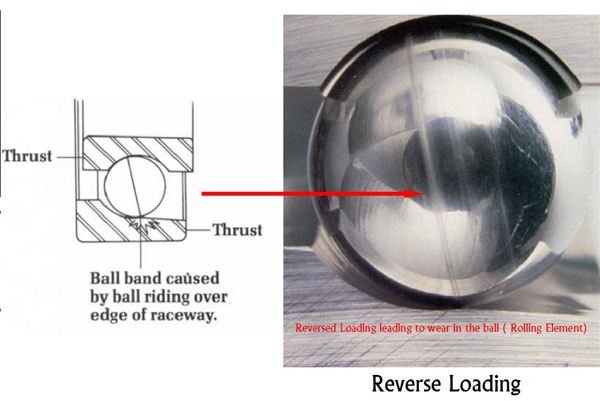Failure modes of Rolling Bearings - Part 4
Just like all living beings, which are designed by nature to move in the forward direction, but they tend to fall down or slow down drastically when they are made to move backwards. The same principle applies to the bearings too. Certain bearings are specifically designed to carry loads in only one direction. For example a cylindrical roller bearing (NU Type) can only carry radial loads and no axial load can be carried by the bearing. Any axial load occurring in the shaft which is held by a cylindrical bearing (NU type) will just be passed over to the member which stands in the way of the force.
Reverse Loading Failure is one such failure which occurs due to the bearing getting loaded in the opposite direction in which it is intended to bear the load. This type of failure is quite common in angular contact and thrust bearings. The failure is generally characterized by wear band in the rolling elements (balls or rollers) and a subsequent discoloration in the path of disturbed contact of the rolling elements.
· Causes: By construction angular, thrust and taper roller bearings contain certain barriers which enable them to carry the thrust or axial loads only in one direction. But these barriers are normally present in one side and not on the other. When the load is applied opposite direction, the bearing is made to move away from its path of running on the raceways. This leads to increase in temperature, vibration and ultimately to premature failure. This is normally caused due to improper mounting of the bearings without prior knowledge to determine the direction of force that will occur on the bearing.
· Remedy: Installation of the bearing in the proper position and direction is the only remedy. These types of bearings are clearly marked stating the side it can carry the axial load. Certain cases where loading tends to come from the opposite direction, it is best to choose a suitable bearing capable of bearing loads from both directions and use it.
We will look into the other types of failure in the next article.
This post is part of the series: Failure modes in Rolling Bearings
Bearings are normally designed and selected to last for a life time. Any failure occurring in it needs to be identified properly. This article will help you in determining the various causes and the type of failure the causes tend to induce on the bearing.
- Failure modes in Rolling Bearings – Part 1
- Failure Modes in Rolling Bearings - Part 2
- Failure Modes in Rolling Bearings - Part 3
- Failure modes in Rolling Bearings - Part 4
- Failure Modes in Rolling Bearings - Part 5
- Failure Modes in Rolling Bearings - Part 6
- Failure modes of Rolling Bearings - Part 7
